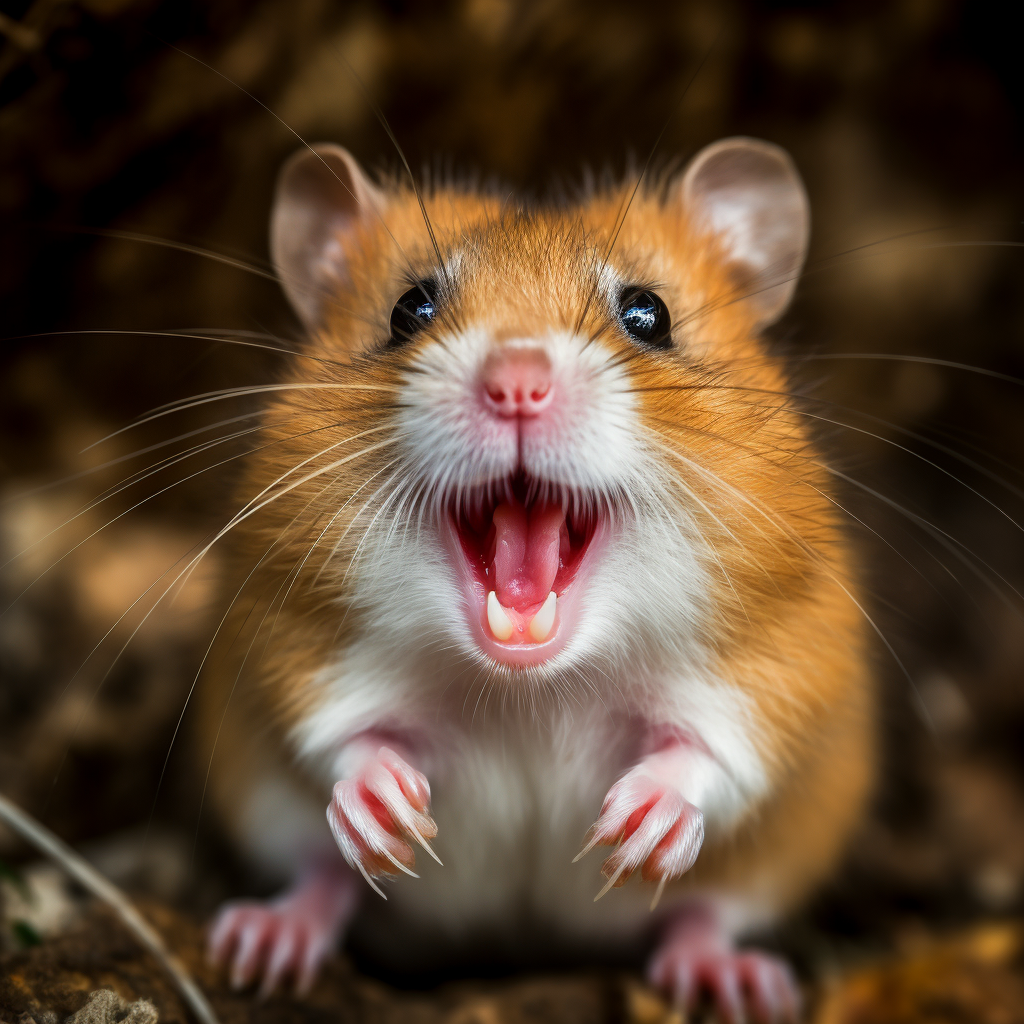Hamsters are small, adorable creatures that are popular pets all over the world. While they may seem harmless, these furry little animals have a set of sharp teeth that are incredibly important for their health and well-being. In fact, a hamster’s teeth never stop growing, and without proper care, they can become a serious health issue. In this blog post, we’ll take a closer look at hamster teeth health, why its so important, how they grow, and what you can do to keep your hamster’s teeth healthy and strong. Whether you’re a new hamster owner or a seasoned pro, this post is sure to provide you with some valuable insights into these fascinating creatures.
Table of Contents
How Many Teeth Do Hamsters Have?
Hamsters are cute and furry little creatures that are popular as pets around the world. However, when it comes to taking care of them, there are many things to consider. One of the questions often asked by new hamster owners is “How many teeth do hamsters have?”
Hamsters have 16 teeth in total. These teeth are sharp and are designed for gnawing and chewing on hard objects. They have four incisors, which are located at the front of their mouths and are used for cutting and biting into food. The remaining 12 teeth are molars and are located toward the back of their mouths. These molars are used for grinding and chewing on food.
It is important to note that hamster teeth grow continuously throughout their lives. This means that they need to constantly gnaw on objects to wear their teeth down and prevent overgrowth. Giving them chew toys, wooden blocks or even cardboard can help them maintain their teeth.
Hamster Dental Care
Hamster dental care is an essential part of keeping your furry friend healthy and happy. The first step in hamster dental care is to provide your hamster with a diet that promotes good dental health. Hamsters need a diet that is high in fiber, such as hay, fresh vegetables, and fruits. This type of diet will help them wear down their teeth naturally as they chew.
Additionally, providing chew toys or wooden blocks is an excellent way to keep your hamster’s teeth in good condition. These toys will help keep their teeth properly aligned and prevent overgrowth.

It is also important to regularly check your hamster’s teeth for signs of overgrowth. If you notice that your hamster is having difficulty eating or is drooling excessively, it may be an indication of dental problems. In such cases, it is advisable to take your hamster to a veterinarian who specialized in small animals.
Finally, if your hamster’s teeth become overgrown, it is essential to seek professional help. Trimming or filing the teeth should be done by a veterinarian who is experienced in handling small animals, as it requires special tools and techniques.
The Anatomy of Hamster Teeth Health
The anatomy of hamster teeth is like that of other rodents. Hamsters have 16 teeth in total, with four incisors located at the front of their mouths and twelve molars located towards the back. The incisors are long and curved and are used for biting and gnawing into food and objects. The molars are flat and used for grinding and chewing on food.
Hamster teeth are made up of a hard outer layer called enamel, which is the hardest substance in the body, and a softer inner layer called dentin. The roots of their teeth are surrounded by a layer of bone called the alveolar bone, which helps keep their teeth securely in place.
Unlike human teeth, hamster teeth continue to grow throughout their lives. This is because they wear their teeth down through constant gnawing and chewing on objects. Overgrown teeth can cause dental problems, so it is important to provide them with proper chew toys and a healthy diet to wear their teeth down naturally.
Common Dental Problems
Hamsters are prone to several dental problems that can cause discomfort and pain. Here are some of the most common dental problems in hamsters:
Overgrown teeth: As mentioned earlier, hamster teeth continue to grow throughout their lives. If they do not wear down naturally, they can become overgrown and cause pain, difficulty eating, and infections.
Malocclusion: Malocclusion is a condition in which the teeth are misaligned, leading to overgrowth, pain, and difficulty eating.
Tooth decay: Hamsters can develop tooth decay if they consume a diet high in sugary or starchy foods, which can lead to cavities and infections.
Broken teeth: Hamster teeth can break due to accidents or trauma. Broken teeth can cause pain and difficulty eating and can also lead to infections.
Abscesses: Abscesses can form in the gums or teeth due to bacterial infections. These can cause swelling, pain, and discharge.
Inflammation: Inflammation in the gums or mouth can be caused by bacterial infections, trauma, or dental problems. It can cause pain and difficulty eating.
Why Are Chew Toys Important for Hamsters?
Chew toys can help prevent overgrown teeth by providing a safe and appropriate surface for hamsters to gnaw on. These toys help keep their teeth properly aligned and prevent overgrowth. Additionally, chewing on toys can help relieve stress and boredom, which is important for the mental and emotional well-being of your hamster.
Here is a link to a series of toys that we really like from Wepets.
Chew toys also provide a source of entertainment and stimulation for hamsters. They love exploring and interacting with their environment, and chew toys can help provide an outlet for this natural behavior. This can help prevent destructive behavior such as chewing on cage bars, which can harm their teeth and lead to other health problems.
Understanding Hamster Teeth Gnawing Behaviour
Hamster gnawing behavior is a natural and instinctive behavior that is important for their dental health and overall well-being. Hamsters have continuously growing teeth that need to be worn down to prevent overgrowth.
Gnawing on objects is one of the primary ways that hamsters wear down their teeth. They have strong jaws and sharp teeth that can easily gnaw through a variety of materials, including wood, cardboard, and plastic. Hamsters will often chew on the bars of their cage or other objects in their environment to satisfy their gnawing instinct.
In addition to wearing down their teeth, gnawing behavior also serves other purposes for hamsters. It can provide a source of mental and emotional stimulation, as well to relieve stress and anxiety. Hamsters also use gnawing behavior to mark their territory and communicate with other hamsters.
It is important to provide hamsters with safe and appropriate objects to gnaw on, such as chew toys made specifically for small animals. Avoid giving them objects that are too hard or can easily break, as this can cause injury to their teeth or other parts of their body.
How to Identify Overgrown Teeth
Identifying overgrown teeth in hamsters can be challenging because they often hide signs of dental problems until they become severe. However, there are a few signs to look out for that may indicate overgrown teeth:
Difficulty eating: If your hamster is having difficulty eating or appears to be avoiding food altogether, it may be a sign of dental problems, including overgrown teeth.
Drooling: Excessive drooling or wetness around the mouth may be a sign of dental pain or discomfort.
Loss of weight: Overgrown teeth can cause pain and difficulty eating, which can lead to weight loss in hamsters.
Changes in behavior: If your hamster appears more irritable or is avoiding social interactions, it could be a sign of dental pain.
Visible signs: In some cases, you may be able to see overgrown teeth by gently opening your hamster’s mouth and inspecting its teeth. However, this should only be done by a trained veterinarian or experienced animal handler.
Regular dental checkups by a veterinarian who is experienced in handling small animals can help detect overgrown teeth and other dental problems early and treat them before they cause more severe complications.
How to Trim Hamster Teeth
Trimming hamster teeth can be a delicate and challenging task, and it is generally recommended to have it done by a veterinarian who is experienced in handling small animals. However, here are some techniques that may be used for trimming hamster teeth:
Manual filing: A veterinarian may use a small file or dental burr to manually file down the hamster’s teeth. This method requires skill and precision to avoid injuring the hamster’s mouth.
Power tools: In some cases, a veterinarian may use a small rotary tool or dental drill to trim down the hamster’s teeth. This method can be more efficient than manual filing but requires more skill and experience to avoid injuring the hamster.
Sedation: Depending on the severity of the dental problem, a veterinarian may need to sedate the hamster to trim their teeth safely and effectively. Sedation carries some risks, so it should only be done by a trained professional.
Diet management: Providing your hamster with a diet that promotes healthy teeth and prevents overgrowth can help prevent the need for tooth trimming. A diet that includes plenty of hay, fresh fruits and vegetables, and appropriate chew toys can help keep your hamster’s teeth healthy and properly worn down.
It is important to note that trimming hamster teeth should only be done by a veterinarian who is experienced in handling small animals. Attempting to trim your hamster’s teeth at home can be dangerous and should be avoided. Regular dental checkups and proper dental care can help prevent the need for tooth trimming in the first place.
Comparing Hamster Teeth to Other Rodents
Like all rodents, hamsters have continuously growing incisors that must be worn down to prevent overgrowth. However, the shape and size of hamster teeth can vary depending on the species. For example, some species of hamsters have shorter, broader teeth, while others have longer, thinner teeth.
Compared to other common pet rodents such as rats and mice, hamster teeth are generally shorter and thicker. This may be due to differences in diet and feeding behavior, as hamsters are known to gnaw on harder objects than rats or mice.
Another notable difference between hamster teeth and other rodents is the presence of “cheek pouches” in some species of hamsters. These pouches allow hamsters to store food and carry it back to their burrows to eat later. The presence of cheek pouches does not affect the structure or function of their teeth, but it does impact their feeding behavior and may require additional dental care.
In conclusion, proper dental care is essential for maintaining the health and well-being of hamsters. Hamsters have continuously growing incisors that must be worn down through regular gnawing and appropriate chew toys to prevent overgrowth and other dental problems. Dental problems in hamsters can manifest in various ways, including difficulty eating, drooling, weight loss, and changes in behavior. Regular dental checkups by a veterinarian who is experienced in handling small animals can help detect dental problems early and treat them before they become more severe. Techniques for trimming hamster teeth should only be done by a trained veterinarian to avoid injury to the hamster’s mouth. Providing your hamster with a healthy diet that promotes healthy teeth and appropriate chew toys can help prevent dental problems from occurring in the first place. By following these guidelines and providing proper dental care, hamsters can live happy and healthy lives with strong, healthy teeth.

